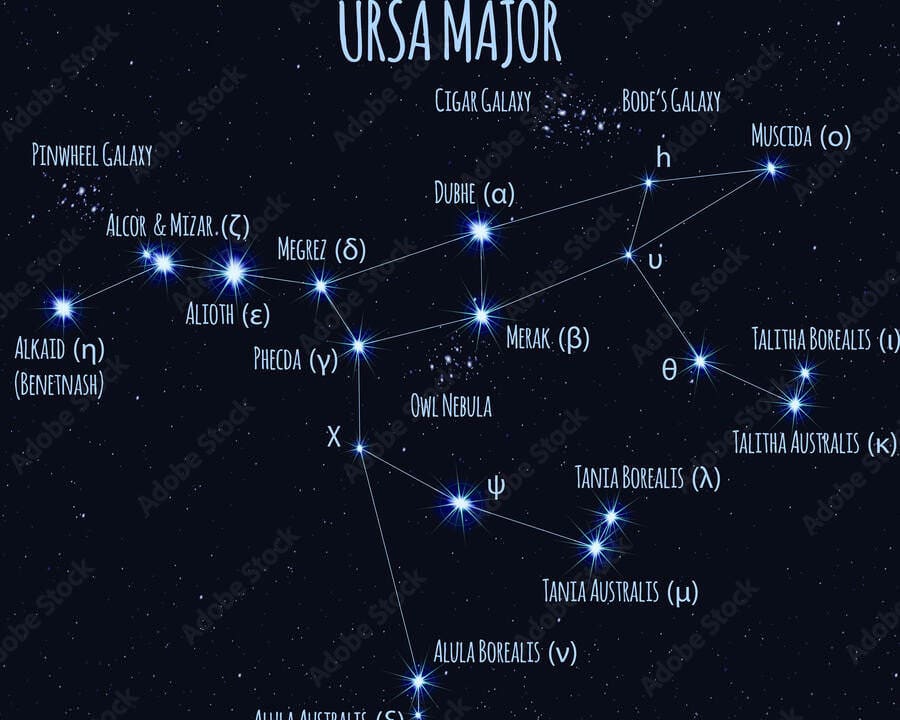The Big Dipper, known as the third largest constellation by area (following Hydra and Virgo), is formed by its seven prominent stars.
Our current time is 100,000 years ahead of when the Big Dipper was first illustrated.
You can use the Ladle to determine the time. In the evening, the Ladle is filled with “water”, and if half of the “water” is emptied, it is close to midnight. By morning, there is hardly any “water” left in the Ladle.
The Big Dipper constellation is represented on the flag of Alaska. Against a blue backdrop, there are eight golden (yellow) stars with five points each: seven representing the Big Dipper and Polaris located in the upper right corner. The Big Dipper symbolizes strength, while Polaris symbolizes the north (as Alaska is the northernmost region of the United States).
Quiz questions: 1. What is the name of the Big Dipper? A) cup, B) ladle, C) jar. 2. The Big Dipper is… A) a constellation, B) a star, C) a planet. 3. Which is the largest constellation by area? A) the first, B) the third, C) the second. 4. How many stars make up a constellation? A) 3, B) 9, C) 7. 5. In which hemisphere is the Big Dipper located? A) northern, B) southern, C) western. 6. Which season provides the best conditions for viewing the Big Dipper? A) fall, B) spring, C) winter. 7. Please sketch the Big Dipper.
Preview:
Our beautiful planet
– You are familiar with it, right?
Every single day and every single year
Goes through a revolution.
And from our Earth
♪ It appears to be rotating ♪
♪ It’s not the Earth that’s rotating ♪
But rather all the stars and the moon.
However, the POLAR STAR
Remains stationary!
And in each season of the year
At the center of the circle
You can locate it
If you happen to lose your way
The axis of the Earth
# It’s the center of the Earth’s axis
You can be certain
That it’s the NORTH!
That star is not merely a dot
It’s the paw of the Bear’s daughter!
Mama Bear’s black nose
That’s precisely where it’s pointing!
I can identify it by the Pitcher!
There are seven stars shining in this area,
And these are their names:
DUBHE illuminates the darkness,
Beside him glows a MERAC,
On the side is FEKDA with MEGRETZ,
"A handsome individual.
From MEGRETZ to the rear
There’s ALIOT,
And behind him are MITSAR and ALCOR.
(These two radiate with joy).
Completing the ladle
Is the unparalleled BENETNASH.
Methodical Developments, Presentations, and Notes: Exploring the Topic
Research Project: “The Bear River”
Students will have the opportunity to discover the fascinating aspects of the Medveditsa River, including its unique geographical features. Additionally, they will delve into the reasons behind the annual decrease in water levels in this particular river.

"The Abundance of Water in the Volgograd Region – Volga, Don, Khoper, Medveditsa, Akhtuba"
– The objective is to introduce students to the vast water resources in the Volgograd region;- To develop their ability to locate rivers on a map and accurately identify them – Volga, Don, Khoper, Medveditsa, Akhtuba;- To organize and reinforce children’s knowledge.

Engaging in extracurricular activities centered around the theme: “Crafting a mythical story.” What was the origin of the celestial formation known as the Ursa Major?
Exploring the World. Initiative: “A mythical tale about the Polaris and the Ursa Minor constellation”
This proposed initiative is being conducted in the realm of the “Environment” subject area. Its inception was motivated by a task assigned in the textbook notebook authored by A. A. Pleshakov titled “Environment”, geared towards second-grade students (UMK).
Presentation “Constellation of the Big Dog” by a fourth-grade student – A Zherdeva Sofya.
On a clear day, one can observe numerous luminous objects of varying sizes in the sky, resembling a scattering of precious diamonds that embellish the celestial dome. These luminous objects are commonly known as stars. Some of these stars appear to be clustered together, forming what is called a constellation.
Unique Psychological Game “Constellation”
Relevance: Each child possesses individuality. They differ from one another in the way they laugh and play. And for a child in elementary school, their parents are there to teach them.
Project “Giant Bear”
The Sanagin land is renowned for its extraordinary life-giving energy, a spirit that is not confined to the past or the future, but exists in the present, timeless power that is filled with captivating challenges.
The seven stars that make up the Big Dipper form a shape resembling a ladle with a handle. The two brightest stars are Alioth and Dubhe.
This is the third largest constellation by area, consisting of seven bright stars that form the famous Big Dipper.
This constellation has been recognized since ancient times among various cultures by different names: Plow, Elk, Wagon, Seven Sages, and more. Each star in the Big Dipper also has its own Arabic name: Dubhe, meaning “bear”; Merak, meaning “loins”; Fekda, meaning “thigh”; Megretz, meaning “beginning of the tail”; Aliot, Mitsar, meaning “girdle” or “loincloth”. The final star in the handle of the Big Dipper is known as Benetnash or Alqaid in Arabic, which translates to “leader of the mourners.”
Interestingly, the five inner stars of the Big Dipper form a distinct cluster in space known as the Sirius Supercluster, which moves rapidly across the sky. Dubhe and Benetnash move in the opposite direction, causing the shape of the Big Dipper to change significantly over a span of approximately 100,000 years.
The human eye is capable of distinguishing 125 stars within the Big Dipper constellation.
During a night with clear skies, direct your attention towards Mizar, the star located in the middle of the handle of the Big Dipper. Adjacent to Mizar, you will easily discern a small, dimly glowing star with a magnitude of 5M, known as Alcor by medieval astronomers. Mizar and Alcor are the most well-known and easily visible binary stars.
In approximately 200 million years, the configuration of stars within the constellation will undergo significant changes, rendering it nearly unrecognizable.
For additional recommended reading, consider exploring the Journey to the constellation of the Little Bear.
Attic of Lost Thoughts – Artist Rinat Voligamsi Big Dipper.
Konstantin Fyodorovich Yuon’s artwork “New Planet.”
The painting “New Planet” by Konstantin Yuon can be described as a piercing feeling, a carving delight, and a scorching emotion. It is not just the vibrant colors and drawn figures that capture one’s attention in this piece, but also the intense sensation of endings and beginnings merging into a singular moment. The contrast and volumetric depiction of the light bursting from the ground, the blindingly huge planets above people’s heads, and the characters’ mixture of horror and admiration as they perish in the rays of a new world’s birth all deeply penetrate the soul.
In 1921, Konstantin Yuon created this artwork, capturing a moment in history when the world was in upheaval, with revolutions and discoveries shaking the foundations. During this time, the Russian state underwent a complete transformation, giving rise to a new country and a new era. The painting reflects the uncertainty and chaos of society, with people depicted in states of suffering or jubilation. Yuon’s canvas beautifully portrays the boundary between the old world’s demise and the birth of a new world, reminiscent of a rising sun. The artwork encapsulates the intense fires of change, where everything is ablaze and aflame.
Incidentally, Konstantin Fyodorovich Yuon was an artist who primarily focused on painting Russian landscapes and churches, making it atypical for him to be the creator of this particular painting. “New Planet,” with its vibrant colors and emotive expression, stands apart from his other works. This departure from realism, in my opinion, was a result of an inspired impulse triggered by the events unfolding in the world and the country during that time, fueling heightened emotions that drove him to create this masterpiece. I believe that within “New Planet” still lingers the same motive and emotion that compelled the painter to suddenly embrace futurism, and this intensity of experience that the artist once felt transcends time and space, becoming palpable for the modern observer.
However, upon my initial viewing of this painting, I was unaware of its historical context. I simply gazed at it intently, allowing my mind to construct images and fragments of a narrative that I had created. This artwork conveyed a vivid story to me, depicting humanity’s final day and the range of emotions experienced in its last moments before plunging into oblivion. It portrayed the godlike figure of Mars, seething with anger towards his negligent descendants. Despite the ultimate outcome of death depicted on the canvas, the artist’s skillful brushwork brought forth the essence of life itself – its beauty and agony. This evoked a gamut of emotions within me, causing laughter and tears, joy and sorrow, love and hatred.
The dark sky is adorned with an infinite number of stars, although only approximately 6000 can be seen with the naked eye. However, even these stars can be challenging to navigate. Throughout history, astronomers from various cultures have created constellations based on their legends, beliefs, and understanding of the universe. These constellations, which are made up of bright star groupings known as asterisms, can represent a variety of different shapes and figures. For instance, the well-known Big Dipper in the constellation Ursa Major is not always associated with a dipper or a bear.
Egypt
Egypt is a country located in North Africa.
China
China is a country in East Asia. It is the most populous country in the world, with over 1.4 billion people. China is known for its rich history and cultural heritage. It has a diverse landscape, ranging from mountains and plateaus to deserts and coastal areas. The country is also famous for its delicious cuisine, including dishes like Peking duck and dim sum. Additionally, China is a global economic powerhouse, with a rapidly growing economy and a strong manufacturing sector. The country is also home to several famous landmarks, such as the Great Wall of China and the Forbidden City. Overall, China is a fascinating and vibrant country with a lot to offer visitors.
Ancient Chinese astrologers divided the celestial sphere into 28 vertical sectors known as “houses,” which the Moon traverses during its monthly journey. This is similar to how the Sun passes through the signs of the Zodiac in Western astrology, a system borrowed from the Egyptians that is divided into 12 sectors. At the center of the celestial sphere, the Chinese placed Polaris, also known as the North Star, which had already assumed its customary position. The seven brightest stars of the Big Dipper are located close to Polaris within the Purple Enclosure, one of three Enclosures surrounding the “royal” star’s palace. These stars can be referred to as the Northern Bucket, and their alignment corresponds to the seasons or as part of the carriage of the Heavenly Emperor Shandi.
Ancient India did not see the same level of advancement in observational astronomy as it did in mathematics. The ideas and teachings in astronomy were greatly influenced by both Greece and China. For instance, the concept of the 27-28 “stands” (nakshatras) that the Moon passes through in about a month bears a striking resemblance to the Chinese lunar “houses”. The Hindu tradition also placed significant importance on Polaris, which was believed to be the dwelling place of Vishnu according to the experts of the Vedas. The Bucket asterism, located below Polaris, was considered to represent the Saptarishas – the seven sages who were born from the mind of Brahma and are regarded as the ancestors of our current era (Kali-yuga) and all its inhabitants.
Greece
Greece is a country located in southeastern Europe. It is known for its rich history and cultural heritage. Greece is famous for its ancient ruins, such as the Parthenon in Athens and the Palace of Knossos in Crete. The country is also known for its beautiful beaches, crystal-clear waters, and delicious cuisine. Greek food is characterized by its use of fresh ingredients, olive oil, and herbs. Popular dishes include moussaka, souvlaki, and tzatziki. In addition to its natural beauty and culinary delights, Greece is also home to a vibrant nightlife scene, with lively bars and clubs. Whether you’re interested in history, relaxation, or partying, Greece has something to offer for everyone.
The Big Dipper is one of the 48 constellations listed in the star catalog by Ptolemy around 140 BC, although its mention predates this, dating back to the time of Homer. The intricate Greek myths present various explanations for its appearance, but they all agree that the bear represents the beautiful Callisto, the companion of the huntress-goddess Artemis. According to one version, employing his usual tactics of reincarnation, the amorous Zeus seduced her, provoking the wrath of his wife Hera and Artemis herself. Coming to the rescue of his lover, the god of thunder transformed her into a bear, who roamed the mountain forests for many years until her own son, fathered by Zeus, encountered her while hunting. The supreme deity had to intervene once more. In order to prevent matricide, he brought them both to the heavens.
The United States of America
It appears that the Native Americans had a certain understanding of untamed creatures: according to a legend from the Iroquois tribe regarding the creation of the constellation, the “celestial bear” is depicted without a tail. The three stars that make up the handle of the Big Dipper represent three hunters in pursuit of the animal: Aliot is depicted drawing a bow with an arrow lodged in it, Mitzar carries a cauldron for cooking meat (depicted as Alcor), and Benetnash carries a bundle of kindling to light the fire. During the autumn season, as the Big Dipper rotates and sinks closer to the horizon, the blood from the wounded bear drips down, staining the trees with a patchwork of colors.
The Big Dipper is a well-known group of stars that is part of one of the largest constellations in the sky. It covers a significant portion of the night sky and is home to not only stars, but also a number of distant galaxies, including the famous Vertushka galaxy (NGC 5457). This galaxy can be found to the northwest of Benetnash, which is the outermost star in the “handle” of the dipper. It is now understood that the five stars that make up the dipper, excluding Dubhe and Benetnash, are part of a single star cluster known as Kolinder 285. These stars share a common origin and motion, and their center is located 80 light-years away from the Sun. This makes Kolinder 285 the closest star cluster to us, and it is currently moving towards us at a speed of nearly 50 km/s.
Alina Eremeeva, a senior researcher at MSU GAISH and a renowned historian of astronomy:
“The Chinese chronicles of the 3rd millennium BC provide detailed accounts of the systematic observations of the stars in the Big Dipper. These observations revealed that the position of the Dipper’s handle changed in the evening. At that time, the pole was near the alpha of the Dragon constellation, and the Dipper appeared to revolve around it, with its orientation varying in different seasons. By closely examining this rotation, one can easily see how it could have served as the probable inspiration for the swastika, a symbol representing eternity and the continual passage of time. This connection is indirectly supported by the traditional design of one of China’s greatest inventions, the compass, which took the form of a ladle with a handle pointing south. It is my hope that understanding the true meaning behind this ancient symbol will help to restore its reputation, which has been tarnished by its association with fascism.”
Interesting facts, informative articles, photos and pictures about the Big Dipper constellation
Observing the night sky, it is not difficult to spot the Big Dipper constellation. Gazing into the vast expanse of cosmic space, one can easily identify seven particularly bright stars. These stars, classified as second magnitude, are accompanied by an additional 126 stars within the constellation that are brighter than the sixth magnitude.
Situated in the northern hemisphere, the Big Dipper is the third largest constellation in the sky. Spanning an area of 1280 square meters, it surpasses the size of the well-known “Bucket with a handle”.
Ursa Major constellation
There is another legend associated with Zeus. When he was a baby, Zeus transformed into a snake and his caretakers into bears to hide from his father Kronus, who had a habit of eating his newborn children. This is how the constellations of Draco, Ursa Major, and Ursa Minor were formed. It should be noted that Draco is not actually a part of the sky, it is most likely the Dragon constellation. All three constellations are located in close proximity to each other, which supports the myth.
For astronomers, the Big Dipper serves as a special point of reference for locating other constellations in the sky. It provides a clear and precise representation of the daily visible movement of the sky. Through a telescope, astronomy enthusiasts can observe variable and binary stars within this constellation that are not visible to the naked eye. It is even possible to identify certain galaxies using a telescope, including the renowned “exploding” galaxy M82.
What makes the Big Dipper particularly fascinating is that some scientists consider it a probable source of extraterrestrial intelligence. Within this region of space lies a star called 47UMa. Its planetary system bears a striking resemblance to our own solar system. In 2003, a radio message was sent in its direction, and it is possible that our intelligent counterparts may still reply to Earth’s call.
Further reading:
Big Dipper – WikiSofia
Big Dipper. Artwork created by Maria Leontieva
The Big Dipper symbolizes the Seat of Enlightenment, serving as the starting point for the world’s transformation (the humanization of deities and the enlightenment of humanity). From this celestial formation, souls are guided to Earth and it also acts as a guide from Earth to the heavens. The Big Dipper is where the rod of AMDH is kept, representing the nurturing aspect of both gods and humans.
On the constellation of the Great Bear, the sacrament of the Immaculate Conception takes place, representing the transmission of original purity. As the Mother ascends on Bel-Beru, she welcomes those who deeply revered the Blessed Virgin during their earthly existence, and who yearn for a spiritual rebirth.
The vessel containing the final two hundred million drops
In ancient records of the stars, an alternative name for the constellation can be found: the Vessel of the Great Dipper. The Slavic people revered Bel-Bera in the form of the goddess Makosha – the Mother of the Ladle, the Protector of the Vessel of Eternal Life. These seven stars, shining the brightest in the sky of the north, serve as a mysterious reminder to humanity of the Sacred Chalice.
The Great Dipper serves as the sacred altar that houses the Vessel containing the final two hundred million drops. As a person takes their final breath, they release the last drop… The physical body may perish, but the soul becomes one with the Great Dipper – inexplicably drawn towards the Cup of Cups, embarking on a journey to the immortal realms of the stars along with the invaluable final drop….
Mammalogist
Located on the constellation of Ursa Major, there exists a vessel containing the everlasting milk of the divine Virgin Mother Goddess. According to ancient folklore, the revered goat Amalthea, who nourished the young Zeus with her milk, serves as the archetype for Artemissa of Ephesus, the Mammal-Bearer Galactotrophusa. The milk of Amalthea symbolizes the sacred milk Grail, from which the Celestial Mother drinks the ambrosial elixir that grants immortality to gods and beings from innumerable worlds.
What connects the earthly Bogomils with our benevolent brethren from a distant corner of the universe, millions of light years away? They are both infused with the milk of eternal life from Our Lady of Mammals!
The Benefactor of Celestial Realms
The Great Bear houses an unimaginable amount of cosmic benevolence that is absent in our earthly realm. There is no trace of evil in this celestial abode!
The Matron of countless virtuous galaxies scattered across the universe, Our Lady of Mammals also watches over numerous suns and planets inhabited by benevolent beings.
In her guise as Sophia Pronoia, she holds sway over billions of destinies! She possesses the knowledge to guide each soul towards its ultimate good or harm, overseeing the fates of many worlds simultaneously….
Sophia often holds a book and a chalice in her hands. The mystical scroll contains the Universal Statutes, which she dutifully abides by! Unfortunately, humanity remains unaware that even the slightest violation of these statutes can have tragic consequences for the entire universe.
The Enigmatic Archives of Bel-Bera
Located within the vast expanse of the Big Dipper, the repository of wisdom takes shape, its profound insights inscribed upon delicate, scented scrolls. Only those who have been initiated into its secrets are granted access to this sacred knowledge.
Known as the Mystical Library of Bel-Bera, this extraordinary collection houses a compendium of authentic records chronicling apparitions, messages, and revelations bestowed upon countless worlds by Our Lady throughout the past five centuries.
Upon a pristine ethereal canvas, one can behold the myriad manifestations of Our Lady, each one uniquely tailored to resonate with the diverse civilizations she has visited. The earthbound are privy to a mere fraction of her hypostatic names, a humble offering of a mere one and a half thousand, when compared to the countless millions of manifestations of the Mother of God throughout the vast expanse of the Universe.
When the followers of Christ look up at the Big Dipper, they find the Word of God and unlock a wealth of wisdom, a breathtaking series of mysteries, and the Cathar keys that hold the key to humanity’s salvation…
This sacred place also houses the manifestations of Our Lady.
Resting on the throne of Bel-Bera, there is the Cup of 200 million final drops. The Cup belongs to the One and a half thousand hypostasized Mother of God. It is the Book of Statutes of the Universe.
Related Articles
References
- Some aspects of Hyperborean astrology. // In the book: Blessed John. Astrology of positive constellations. – Moscow, 2012
- Blessed John Bogomil. 16 positive constellations vs. 12 negative zodiacs. – Moscow: Mir Sofia, 2014
Additional Notes
- ↑ Astrology of the 16 good constellations. October 8, 2013, p. 89-97 // In the book: Blessed John. Peninsula of New Martyrs. – Moscow: Mir Sofia, 2014
Changes in Star Patterns: The Evolution of the Big Dipper
As we navigate through the vast expanse of space and time, the celestial landscape undergoes a constant transformation. The patterns of stars that we observe today are not static but ever-changing, influenced by a multitude of factors.
Just like a ship drifting in the ocean, we are carried along on our planet as it revolves around the Sun. Over the course of more than 4 billion revolutions, Earth has witnessed the ebb and flow of cosmic events. But our Sun, too, is not stationary – it is in motion, journeying around the core of the Milky Way galaxy. And our galaxy itself is not isolated; it interacts with and moves amongst a myriad of other galaxies. We are, in essence, perpetual space travelers.
The tiny particles of sand suspended in the atmosphere are approximately equal in size. Over time, these particles undergo compaction and abrasion, eventually transforming into larger rocks through the forces of pressure, friction, and erosion. In the past, when humanity was unaware that stars were distant suns, they appeared to us as mere patterns in the sky. All we had to do was connect the dots.
A Scene from a Sci-Fi Film
The collection of stars known today as the Big Dipper has taken on various interpretations throughout different cultures and time periods. Every civilization, whether ancient or modern, has assigned its own symbols and aspirations to the celestial bodies. From the Chinese government official to the German wagon, these constellations have served as representations of cultural significance. However, ancient civilizations envisioned different constellations due to the relative motion of their celestial components.
We have the ability to input the current position and movement of stars into a computer and use it to calculate patterns from the past. Each constellation represents a single frame in a grand cosmic movie. However, due to the shortness of our lives and the slow changes in the sky, we often fail to notice this ongoing movie.
Many millions of years ago, the Big Dipper did not exist. Our ancestors, as they gazed up at the stars and pondered their significance, saw different patterns in the northern sky. By projecting the constellation Leo into the future, we can determine what pattern it will take on.
In a million years from now, Leo may be known as the Radio Telescope constellation. Alternatively, consider the Whale constellation. A million years ago, it likely had a different name. Perhaps it was called the Spear.
Evolution of Stars
Imagine traveling through billions of nights, witnessing the incredible transformations that occur in the vast expanse of space. In the Orion constellation, not only do the stars move, but they also undergo a process of evolution. Many of the stars in Orion are young and hot, with lifespans that span just a few million years.
If we were to fast forward time in Orion, we would observe the birth and explosive deaths of numerous stars, their brilliance flickering like fireflies in the night sky. Given enough time, we would witness changes in the constellations themselves. However, if we were to extend our journey even further into the future, we would also witness the celestial patterns undergo transformations.
The projection of stars in two dimensions is merely a representation of their scattering in three dimensions. Some stars may appear close but have a dim brightness, while others may appear bright but are actually distant. Is it truly possible for a space traveler to observe the evolving patterns of constellations? To achieve this, one must journey a distance equivalent to the separation between us and the constellation. Currently, we are traversing hundreds of light years while orbiting the Big Dipper.

The magnificent constellation known as the Great Bear has captured the fascination of the people of Bulgaria, who have bestowed upon it the moniker of the Wagon. The origin of this name can be traced back to an intriguing legend. In the days of old, a courageous young man ventured into the depths of the forest with the intention of gathering firewood. As he arrived at his destination, he unhitched his trusty oxen and allowed them to graze peacefully. Unexpectedly, a formidable bear emerged from the dense foliage and swiftly devoured one of the oxen. Undeterred by this harrowing turn of events, the young man summoned his bravery and successfully apprehended the bear, imprisoning her within his wagon as a replacement for the ox she had consumed.
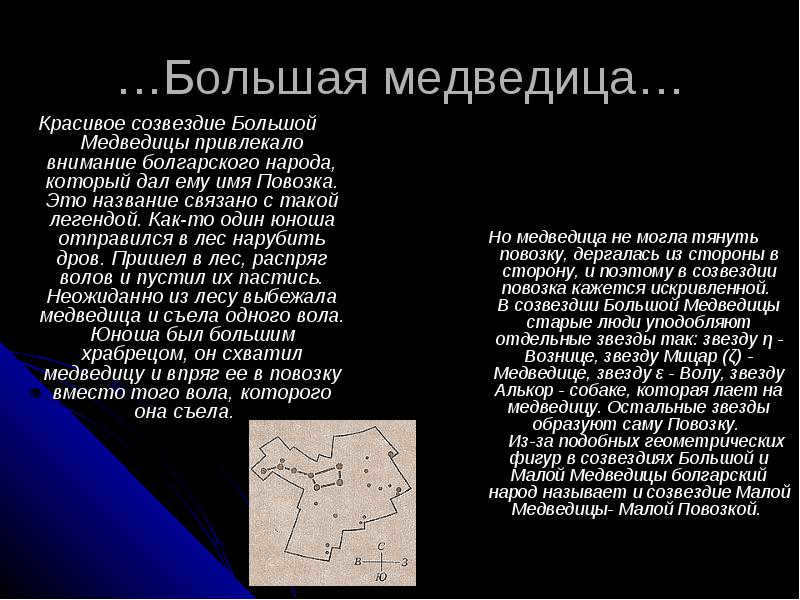
…THE TINY BEAR…
Also known as a close to polar constellation, the Tiny Bear can be observed above the horizon throughout the day. It is almost entirely encompassed by the Dragon constellation, with only the Giraffe constellation located to the north. On a clear and moonless night, this constellation reveals around 20 stars visible to the naked eye, although they are generally dim. Amongst these stars, Polaris stands out as a second magnitude star. The brightest stars form a pattern resembling the Big Dipper, but on a smaller and inverted scale. This is the reason behind the name of this constellation, the Tiny Bear.
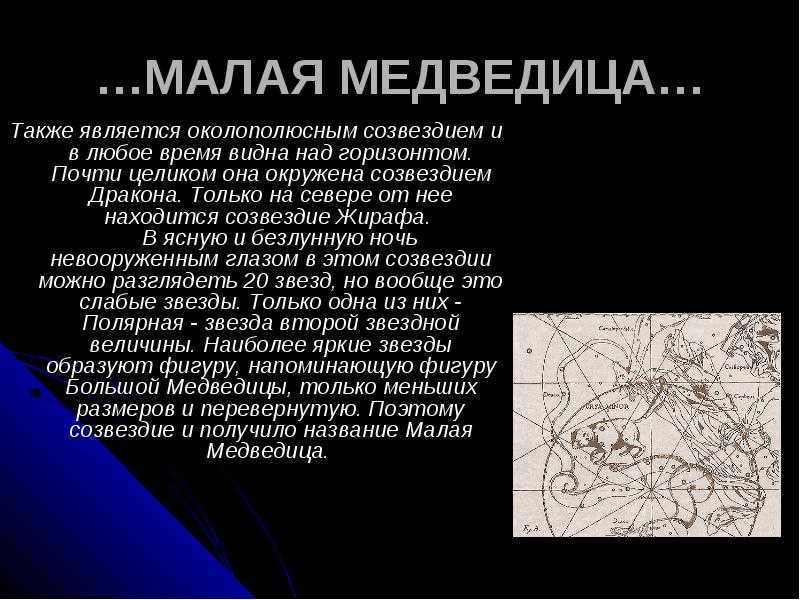
VOLOPAS
One of the most stunning groupings of stars in the sky is the Volopas constellation. It captivates with its unique arrangement, which is created by its brightest stars: an unfurled fan shape resembling a female fan. At the handle of this celestial fan, you will find the magnificent zero magnitude star Arcturus, which shines with a reddish hue. Volopas is at its prime during the period of April through September when it can be best observed at night. It is accompanied by neighboring constellations such as the Northern Crown, the Serpent, Virgo, Veronica’s Hair, the Hound Dogs, and the Dragon.

Legend has it that the constellation of Volopas is a representation of the ancient farmer Triptolemus. According to the story, Demeter, the goddess of fertility and agriculture, bestowed upon Triptolemus an ear of wheat, a wooden plow, and a sickle. She instructed him in the art of plowing the land, sowing the wheat grains, and reaping the bountiful harvest with the sickle. Triptolemus sowed his first field and it yielded an abundant crop.
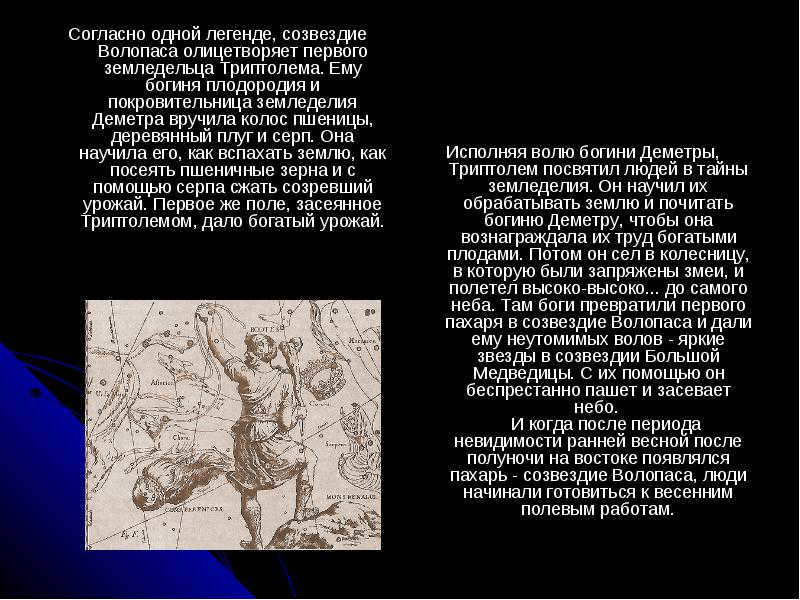
^
…THE CANIS MAJOR CONSTELLATION…
A small group of stars. There are no prominent stars that stand out. It is most visible at night between February and July. It is surrounded by the neighboring constellations of Volopassus, Veronica’s Hair, and the Big Dipper. On a clear night without the moon, around 30 stars can be seen with the naked eye in the Canis Major constellation. These stars are quite dim, almost reaching the limit of visibility, and they are scattered in a haphazard manner that makes it difficult to discern any distinct geometric shape when connecting them with lines.
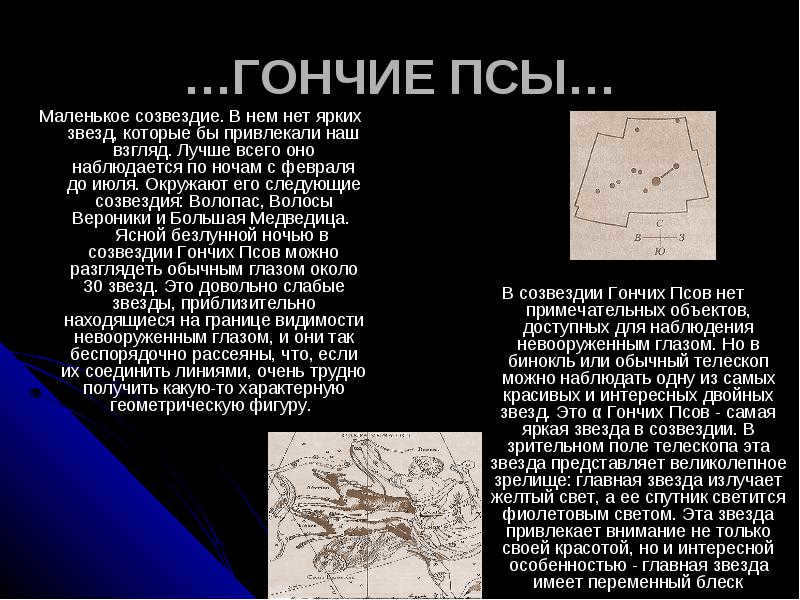

…TRIANGLE…
can be rephrased to
…GEOMETRIC SHAPE WITH THREE SIDES…
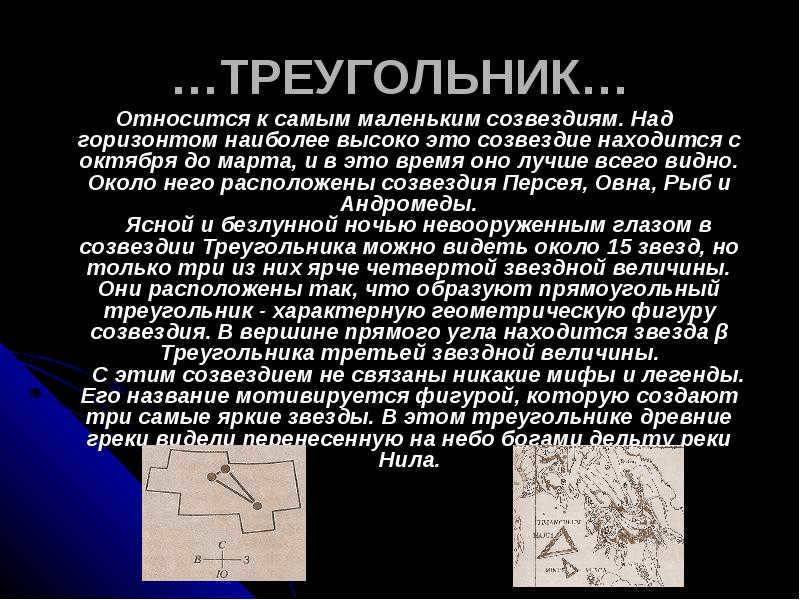
…THE WOLF CONSTELLATION.
The Wolf constellation, also known as Lupus, is located in the southern sky and can be partially observed from Bulgaria during the months of July and August. It is surrounded by the constellations of Scorpius, Naugol, Centaurus, and Libra. On clear and moonless nights, it is possible to see around 70 stars with the naked eye in the Wolf constellation, although only ten of them have a magnitude brighter than the fourth star. Two of these brighter stars are visible from Bulgaria. The brighter stars in the Wolf constellation form a large curved quadrangle. It requires some imagination to visualize the shape of a wolf in this geometric figure, which is how the constellation is depicted on ancient star charts.
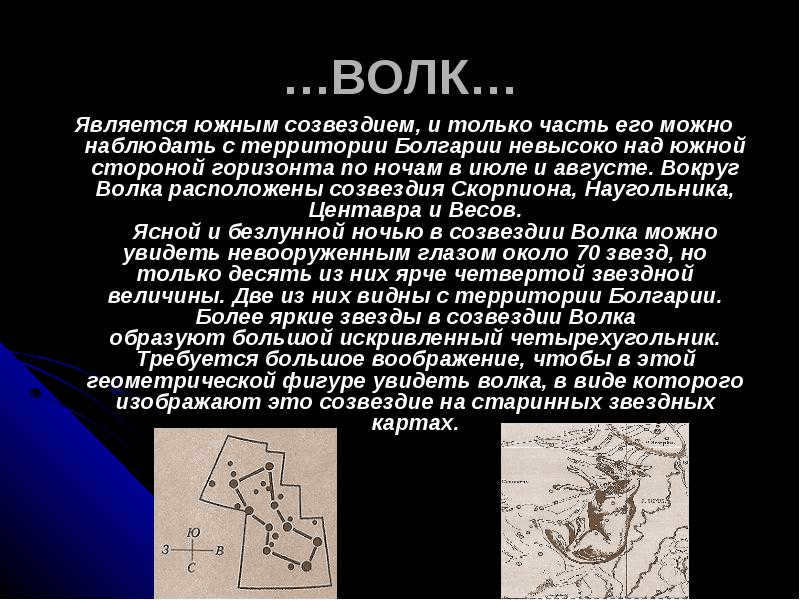
…DELPHINE…
A diminutive constellation. It provides optimal viewing opportunities during the months of July to November. Delphine is encompassed by the constellations of Pegasus, Lesser Horse, Eagle, Arrow, and Foxy. On a clear and moonless night, around 30 stars can be observed with the naked eye in this particular constellation, although they are quite faint. Only three of these stars have a brightness greater than fourth magnitude. Together with another faint star, they create a clearly defined rhombus. In Bulgarian folklore, this pattern is referred to as the Small Cross. It is interesting to note that the ancient Greeks perceived this rhombus as a dolphin, and on ancient star charts, this constellation is depicted as such.
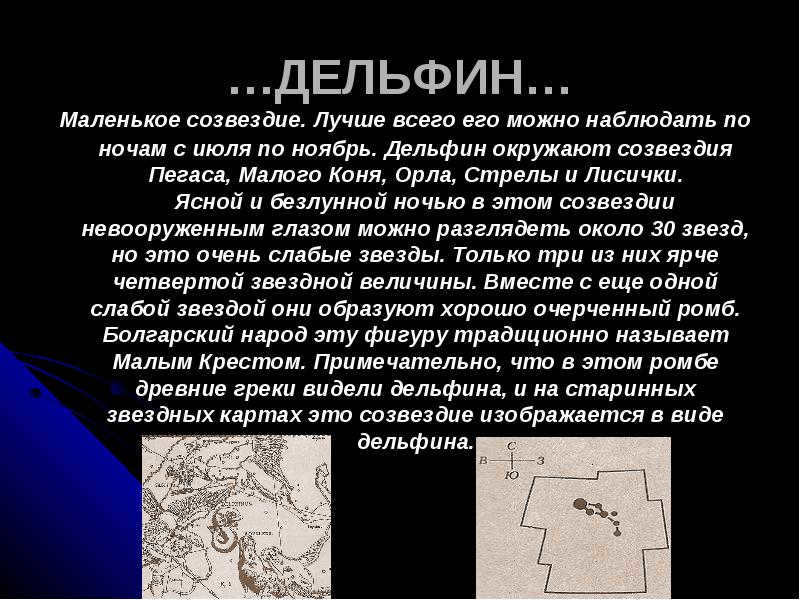
…PISCES…
Pisces is a zodiacal constellation that can be best observed from early October to late January. It is surrounded by the constellations of Aries, Cetus, Aquarius, Pegasus, and Andromeda. On a clear and moonless night, approximately 75 faint stars can be seen with the naked eye in Pisces. Only three of these stars have a magnitude brighter than fourth. By connecting the brightest stars with lines, they form the unique geometric shape of Pisces, resembling an acute angle with its apex at the star α Pisces. One side of the angle faces north and forms a small triangle created by three faint stars. The other side faces west and ends in an elongated pentagon made up of five relatively bright stars. Just west of the western apex of the pentagon lies the star β Pisces, which is the second brightest star in the constellation. To see the two fish depicted on ancient star maps and star atlases, one must have a vivid imagination. The two fish are shown as being separated from each other and connected by a wide ribbon.


^
…The Milky Way…
During the clear nights of July, August, and September, it is likely that almost everyone has observed a milky-white band in the sky that seems to encircle the entire celestial sphere. This band resembles a flowing river as it stretches across the sky. At certain points, the river narrows and flows calmly, but then suddenly overflows and expands. The bright “clouds” are gradually replaced by paler ones, giving the impression of massive waves raging in the celestial river. At a certain juncture, the celestial river splits into two branches, only to reunite and continue as a wide milky-white river that covers the entire celestial sphere. This amazing spectacle is known as the Milky Way.



^
…The Sun in Ancient Greek Mythology…
Once Uranus (Heaven) became the ruler of the entire world, he joined in matrimony with the abundant Gaia (Earth). And from their union, twelve mighty and fearsome titans and titanids were born. Hyperion, one of the titans, and Teia, Uranus’ eldest daughter, had three offspring – Helios (Sun), Selene (Moon), and Eos (Dawn). Far away on the far eastern edge of the Earth, Helios, the god of the Sun, resided in his majestic golden palace. At the break of dawn, when the eastern sky started to blush with a rosy hue, the pink-feathered Eos would open the gates of gold. Out of those gates would emerge Helios, seated in his chariot of gold, pulled by four winged horses as white as the purest snow. Standing tall in the chariot, Helios firmly gripped the reins of his untamed steeds. His brilliant radiance emanated from his flowing golden robe and the resplendent crown adorning his head. His rays first bathed the lofty mountain peaks, causing them to burst into flame-like brilliance. Ascending higher and higher, the chariot of Helios would cast its radiant beams upon the Earth, bestowing upon it light, warmth, and vitality. Once Helios reached the zenith of the heavens, he would commence his gradual descent in his chariot towards the western edge of the Earth. There, on the sacred waters of the Ocean, a golden rook eagerly awaited his arrival. The winged horses guided the chariot, along with its stately saddle, into the rook, and Helios would ride it beneath the subterranean river towards the east, to his opulent golden abode. It is there that Helios would rest during the night. With the arrival of daybreak, he would once again embark on his golden chariot, traversing the celestial expanses, illuminating the Earth with his effulgence and filling it with delight.
In a distant land, where the temperature is always freezing and snow covers the ground, a tiny Little Bear entered the world as a member of a Polar Bear family. The bear was so breathtakingly beautiful that all the creatures of the North flocked to see him. Unfortunately, the arrival of the good animals also attracted the attention of a Wicked Witch who despised all things good and beautiful. Filled with anger towards the White Bear family, the Witch placed a curse upon them. She banished Little Bear to a desolate place where the sky remained hidden, and darkness and coldness prevailed. Despite being both beautiful and brave, Little Bear did not fear the darkness and cold. He was determined to find his parents at any cost. He trekked through mountains and valleys for a considerable period until he encountered a Little Girl along his path. At first, the Girl was frightened by the sight of Little Bear, as she had never encountered a bear before. However, Little Bear sang a comforting song that his mother used to sing, and the Girl’s fear subsided. A smile formed on her face, and the two became fast friends. The Girl revealed that the Wicked Witch had transformed her parents into ice statues and abandoned her in the mountains. She was on a quest to reach the Castle of the Good Enchantress to seek guidance on how to undo the spell. Little Bear and the Little Girl decided to join forces and seek advice from the Good Enchantress regarding their shared sorrow. They journeyed across mountains and fields until they arrived at a magnificent lake adjacent to a beautiful castle. Within this castle resided the Good Enchantress. As soon as she saw Little Bear and the Girl, she rushed out to greet them. The Enchantress invited them inside to rest and enjoy a meal. After the children had eaten, the Good Enchantress inquired about the reason for their visit and the source of their sorrow. The children shared their story, detailing the curse upon their parents and their desire to free them. The Good Enchantress listened attentively and informed them of a legend. In ancient times, when the world was young and devoid of stars, darkness prevailed. People found it difficult to navigate the Earth without any points of reference. The gods of the universe decided to assist the people and divided the sky into four parts. Each god drew various figures, including humans, animals, and mythical creatures, using dots. As a result, the sky became illuminated, and people expressed their gratitude to the gods. The gods revealed that these dots were stars and the drawings represented constellations, serving as guides in the darkness. One traveler inquired about how to navigate using the stars, as it was challenging to determine directions. The chief god responded that they had created a single prominent star, larger and brighter than the others, known as “Polaris.” This star always indicated the direction of the north and became the guiding star. The Stargazer concluded his tale by informing Little Bear and the Girl that they needed to locate the Polar Star, which would lead them to their parents. The children followed this advice diligently. Spotting the Polar Star in the night sky, they proceeded in its direction until they reached the castle. Within the castle dwelled the Wicked Witch, protected by a Golden Dragon. The Dragon posed riddles, and if someone solved them, it would instantly slay the Witch. Initially, the children felt fearful of the Dragon, but their determination to rescue their parents overcame their fear. Little Bear bravely requested a riddle from the Dragon. The Dragon, impressed by Little Bear’s confidence, presented his most challenging riddle: “Tell me, who walks on four legs in the morning, two legs in the afternoon, and three legs in the evening? None of all the creatures living on earth changes like him. When he walks on four legs, then he has less strength and moves more slowly than at other times.” Little Bear and the Girl pondered the riddle for a brief moment. Suddenly, the Girl provided the answer: “It is a man! When he is young, in the morning of his life, he is weak and crawls slowly on all fours. During the day, in adulthood, he walks on two legs. However, in the evening of his life, in old age, he becomes frail and relies on a crutch, thus walking on three legs.” The Dragon marveled at the children’s cleverness and confirmed their answer as correct. Instantaneously, the Wicked Witch vanished, and the parents of Little Bear and the Girl materialized beside them. This is how the fairy tale legend of the constellation “Little Bear” and the Polar Star came into existence.
Throughout history, humanity has always gazed up at the vast and enigmatic sky, pondering its mysteries and marveling at the celestial abode of the stars. Fascinated by this ethereal realm, people have crafted numerous captivating legends, attributing earthly qualities to various constellations. These tales, known as “real star constellation tales,” are deemed real because they reflect the divine script written by God, and individuals whose horoscopes feature a strong emphasis on specific stars become the actors in this cosmic drama.
With this perspective in mind, let us explore the constellation named Swan, located in the northern hemisphere of the sky. This particular constellation holds intrigue as it is within this formation that the star Jenach was discovered in 1846 (?
Neptune, the enigmatic planet, was discovered and given the name Swan. Figure 1 depicts a diagram of this constellation, which features a distinct cross-shaped pattern that extends along the Milky Way. This constellation is now known as the Northern Cross asterism.
The Northern Cross asterism, which defines the unique shape of the constellation, includes the stars – ? (Deneb), ? (Albireo), ? (Sadr), ? and ? Genach (Gienach).
At the center of this cross-shaped formation is the bright star Sadr, which has long been associated with the role of protecting cosmic time. Ancient civilizations perceived the outline of a flying bird within this constellation, with the Babylonians calling it the “forest bird” and the Arabs referring to it as the “chicken”. It is believed that the swan may have been the first constellation observed in the Inter-Areace, as certain tablets depict a large star bird (B. Bredy).
The Swan is a constellation with a long history, and it has been documented in Claudius Ptolemy’s Almagest catalog as the “Bird” constellation. According to Ptolemy, the stars in this constellation exhibit similar characteristics to Venus and Mercury. Additionally, the ancient Greek mathematician and astronomer Eudoxus of Cnidus also mentioned this constellation in his writings.
If you are looking to download a free essay, here is a link to one that may be of interest to you. Additionally, I can create a little fairy tale about the constellation of the Lesser Bear and the Polar Star specifically for 2nd graders. Thank you for considering this.
Geography test in grade 7 on the topic “Oceans”
1. Which ocean has an area of 178.6 million km2? A) Atlantic; C) Arctic; B) Pacific; D) Indian.
2. Which ocean touches the shores of 4 continents? A) Atlantic; C) Southern; B) Indian; D) Pacific.
3. Which current is found in the Atlantic Ocean? A) Kuroshio Current; B) Gulf Stream; C) Somali Current.
4. Which ocean contains the deepest depression on the planet (11022m)? A) Sound Trench; B) Greenland Sea; C) Pacific Ocean.
Correct speech is speech that adheres to the rules and grammar of the native language. Frequent violations of grammar rules in speech are considered illiteracy. Errors in word combinations are known as solecisms in stylistics. Solecisms are often made due to a lack of knowledge of the rules of the native language. For example, errors are frequently made in the abbreviation of adjectival clauses (e.g.: having entered the room, I wanted to sit down). While I am not a prophet, I can see that the moth circling around the candle is almost like a prophecy.
1. What is the unique geographical position of the Arctic Ocean and how does it affect its nature? The Arctic Ocean gets its name from its unique geographical position as the northernmost of all the oceans. A significant portion of the Arctic Ocean is covered in thick ice that remains frozen throughout the year. The harsh Arctic climate makes it challenging for living organisms to thrive. The Arctic Ocean is home to various species of fish, birds, walruses, seals, and polar bears. It borders the northern region of Eurasia.
According to popular belief, a new star appears in the sky on the day a person is born. Sergei Yesenin’s star was destined to shine on September 21 (October 3), 1895. The future renowned lyricist was born in the ancient Russian village of Konstantinovo, Kuzminskaya volost, Ryazan province. His father, Alexander Nikitich Yesenin, worked in a butcher shop in Moscow. His mother, Tatiana Fyodorovna, went to work in the city and left her two-year-old son in the care of his grandparents. FULL BIOGRAPHY
Step #4 – mark the last side with a cross. We now move on to the final layer. However, don’t rush as there are still 4 steps in the last layer, and you’ll need to memorize at least five algorithms. This is because as we approach the final goal of a fully assembled cube, we need to be careful not to disrupt the parts we’ve already solved. When assembling the third layer, we won’t touch the first two layers, and if we do, we’ll only make changes to the first two layers.
Symbol of beauty and purity, the flowers of this extraordinary plant close in the evening and submerge underwater. According to Slavic legend, they transform into beautiful nymph mermaids during the night when immersed in bodies of water. According to an ancient Greek legend, this plant originated from a white nymph who died from unrequited love. This is why the white lily has long been revered by the Slavs as a symbol of purity. Our ancestors honored this plant because of its large and exquisite flowers.
During vacations, many kids visit their grandparents’ village for a rest. Some go on vacation to Turkey or Crimea. However, this summer, we decided to have a “wilderness” vacation. We went to the Kaluga region. My dad’s friend lives in a forest village there, and he had been inviting my dad to visit for a long time and explore the deep forests that still exist in the area. We spent a few days wandering around. My dad and his friend hunted ducks while I enjoyed the peaceful surroundings.

